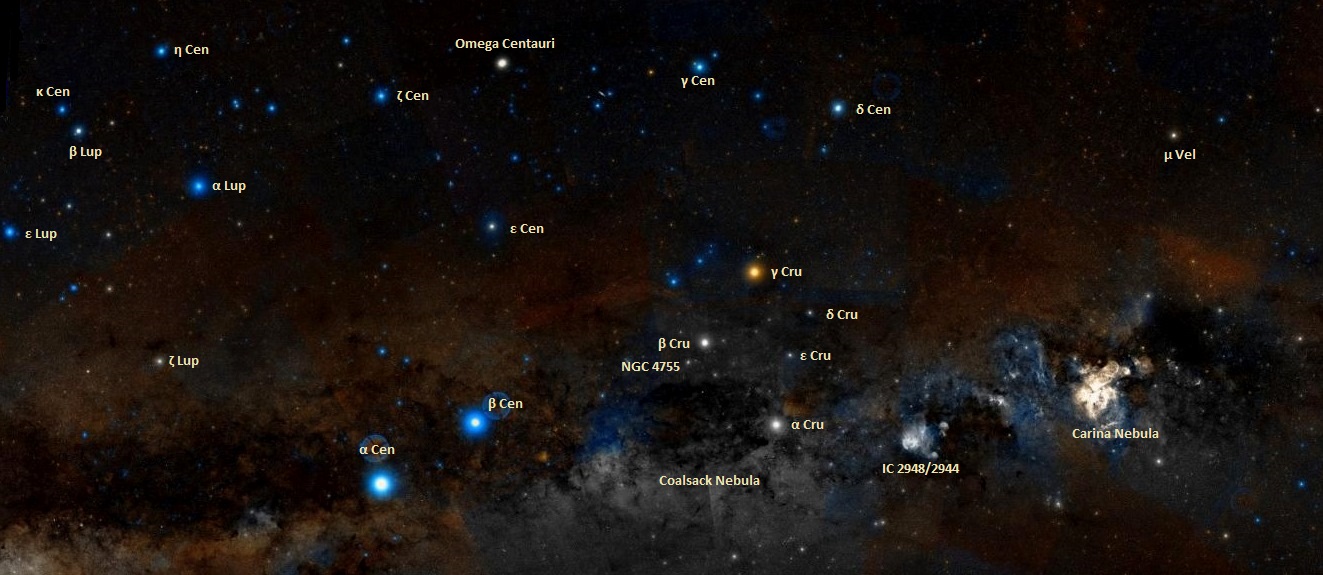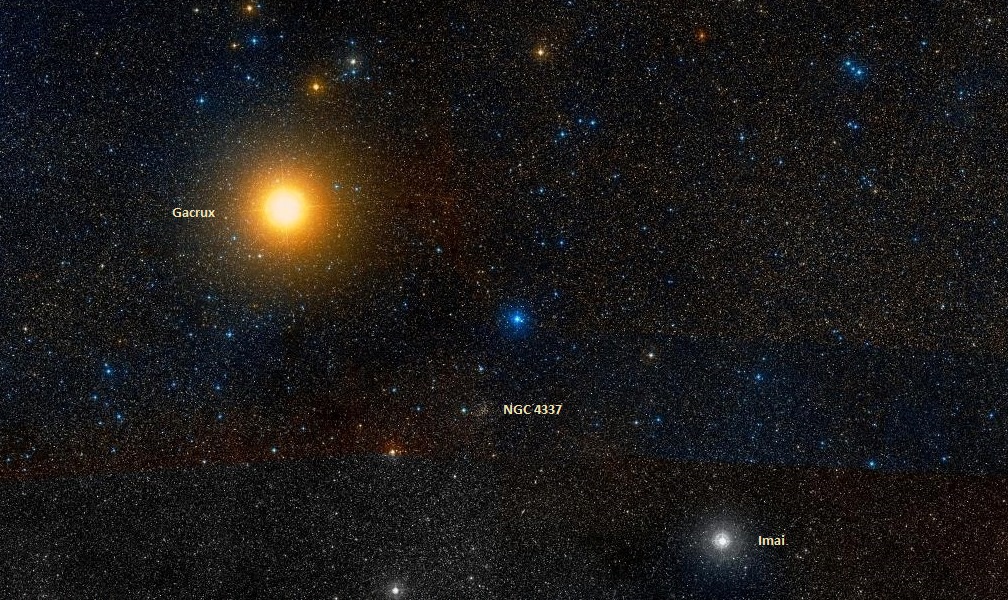Gacrux, Gamma Crucis (γ Cru), is a red giant star located in the southern constellation Crux. With an apparent magnitude of 1.63, it is the third brightest star in Crux and the 25th brightest star in the sky. It is only slightly fainter than Shaula in Scorpius and Castor in Gemini, and it just outshines Bellatrix in Orion, Elnath in Taurus and Miaplacidus in Carina constellation. At an approximate distance of 88.6 light years from Earth, Gacrux is the nearest red giant to the solar system and the brightest star of its class in the sky.
Gacrux is one of the four stars that form the Southern Cross, one of the most prominent asterisms in the southern celestial hemisphere. It is the northernmost (top) star of the Cross and its red colour stands out in contrast to the blue-white (class B) Acrux, Mimosa and Imai. The other three stars are believed to have formed in the same place and lie at similar distances, even though they are not gravitationally bound, while Gacrux is much closer to us and is not a member of the same stellar association.
Star type
Gacrux is a red giant of the spectral type M3.5 III. It has a mass about 1.5 times that of the Sun and has expanded to a size of 84 solar radii. With a temperature of 3,626 K, it shines with about 820 solar luminosities and appears distinctly reddish. Its low mass indicates that it will end its life by ejecting its outer gas envelope into space to form a planetary nebula, leaving behind a planet-sized white dwarf which will eventually fade.
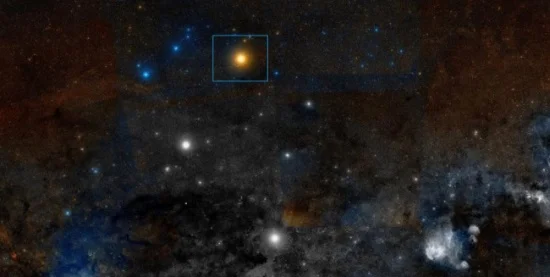
Gacrux (Gamma Crucis), image: Wikisky
The star is believed to be on the red giant branch (RGB) and not the asymptotic giant branch (AGB). The red giant branch is the evolutionary stage of low-to-intermediate mass stars that follows the main sequence, but before helium ignition occurs. However, Gacrux may have also already gone through the helium burning stage and it may now be moving up the AGB as a “second-ascent” giant.
Gacrux is classified as a semi-regular variable star with multiple pulsation periods in the range from 12.1 to 104.9 days and amplitude changes from 0.015 to 0.027 magnitudes.
The star’s atmosphere is enriched with barium, which typically indicates mass transfer from a more evolved companion which will eventually become a white dwarf, but a physical companion has not been discovered yet. There may be a white dwarf companion, but it has so far gone undetected. There is only a magnitude 6.4 line-of-sight companion, a white class A star, visible in binoculars at a separation of 2 arcminutes, but located about four times further away.
Facts
Gacrux and Acrux are among the 58 stars selected for celestial navigation. Navigational stars are some of the brightest stars in the sky, selected because they are bright and can be easily identified. They stretch across 38 constellations, covering the area from the declination +89° to -70° of the celestial sphere.
While it is invisible (and mostly unknown) to most northern observers, the Southern Cross plays an important part in many cultures in the southern hemisphere. Its stars are represented on the flags of Australia, New Zealand, Brazil, Papua New Guinea and Samoa. On the flag of Brazil, each star represents a Brazilian Federative Unit and Gacrux symbolizes the state of Bahia.
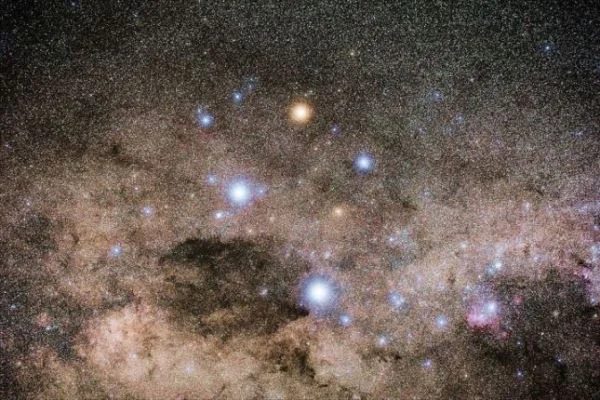
Wide field image of the Southern Cross, credit: Wikimedia Commons/Naskies (CC BY-SA 3.0)
In the culture of the Aranda and Luritja people of the Northern Territory in Australia, Gacrux is part of an asterism known as Iritjinga, meaning “the eagle-hawk.” The quadrangular pattern is also formed by Imai, Muhlifain (Gamma Centauri) and Delta Centauri.
In ancient times, the Southern Cross stars were visible north of latitude 40°N. However, due to the Earth’s axial precession, they have sunk below the horizon for most northern observers. In ancient Greece and Rome, the stars of Crux were visible and considered part of the larger Centaurus constellation.
Name
Gacrux (pronunciation: /ˈɡækrʌks/) is a contraction of the star’s Greek letter designation Gamma and the name of the constellation, Crux. It was coined by the American astronomy writer and cartographer Elijah Hinsdale Burritt in the 19th century.
The name was officially approved by the International Astronomical Union’s (IAU) Working Group on Star Names (WGSN) on July 20, 2016.
The Chinese know Gacrux as 十字架一 (Shí Zì Jià yī), the First Star of Cross. The Chinese Cross asterism is formed by the four Southern Cross stars, Acrux, Mimosa, Gacrux and Imai.
In Brazil, Gacrux is also known as Rubidea, meaning “ruby-like.”
Location
Gacrux lies in the far southern sky and is invisible from most locations in the northern hemisphere.
For southern observers, Gacrux is very easy to find because it is bright, part of the Southern Cross, and it has a pair of exceptionally bright stars, Alpha and Beta Centauri (the Southern Pointers) pointing at it. An imaginary line extended from Alpha through Beta Centauri leads only a degree north of the star.
The stars of the Southern Cross cannot be seen north of latitude 20°N, but they are circumpolar, i.e. never sink below the horizon, from locations south of latitude 34°S. In other words, from most of the southern hemisphere, the stars are visible throughout the year.
Gacrux, Acrux and the Southern Pointers are commonly used to find the south celestial pole. Sigma Octantis (Polaris Australis), the nearest visible star to the pole, has an apparent magnitude of 5.47 and is barely visible even in good conditions. The star’s faintness makes it less useful than its northern counterpart Polaris, Alpha Ursae Minoris, for locating true south. The bright stars of Centaurus and Crux are used instead. The southern celestial pole can be found by extending an imaginary line from Gacrux through Acrux and drawing another line at a right angle to the imaginary line connecting the Southern Pointers. The point where the two lines intersect is close to the pole.
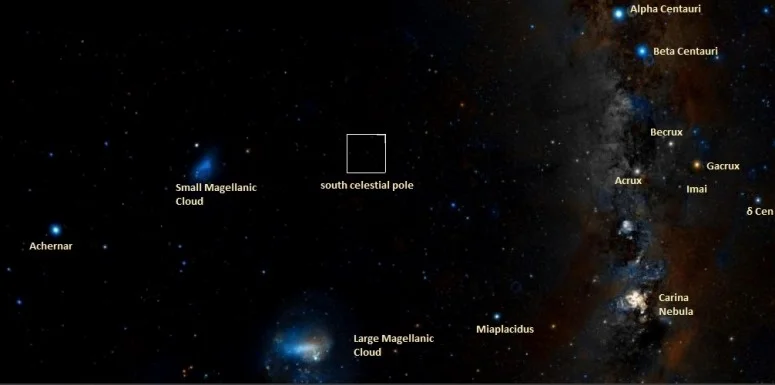
Achernar, the Southern Cross and the south celestial pole, image: Wikisky
Gacrux can also be used to find the star cluster NGC 4337, one of the older open clusters in the Milky Way’s inner disk. The cluster is located in the region between Gacrux and Imai, Delta Crucis, the right star of the Southern Cross.
Constellation
Gacrux belongs to the constellation Crux, the smallest of all 88 constellations. In spite of occupying only 68 square degrees, Crux is a popular telescope target because it contains several interesting deep sky objects. The best known ones are the Jewel Box Cluster (NGC 4755) and the Coalsack Nebula. Also known as the Kappa Crucis Cluster, the Jewel Box is one of the brightest open clusters in the sky. It is located only a degree southwest of Beta Crucis. The Coalsack Nebula, visible between Acrux and Mimosa, covers an area of roughly 5 by 7 degrees and overlaps into the constellations Musca and Centaurus.
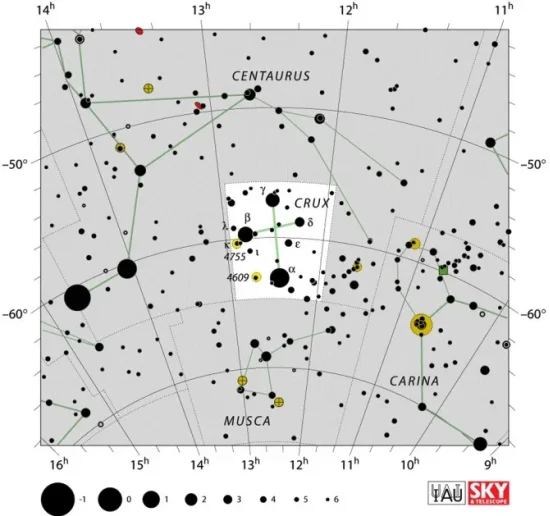
Crux constellation map by IAU and Sky&Telescope magazine
The best time of year to observe the stars and deep sky objects in Crux is during the month of May, when the constellation is prominent in the evening sky.
The 10 brightest stars in Crux are Acrux (Alpha Cru, mag. 0.76), Mimosa (Beta Cru, mag. 1.25), Gacrux (Gamma Cru, mag. 1.64), Imai (Delta Cru, mag. 2.79), Ginan (Epsilon Cru, mag. 3.58), Mu1 Crucis (mag. 4.03), Zeta Crucis (mag. 4.04), Eta Crucis (mag. 4.14), Theta1 Crucis (mag. 4.30), and Lambda Crucis (mag. 4.602).
Gacrux – Gamma Crucis
| Spectral class | M3.5 III |
| Variable type | Semiregular (SRV) |
| U-B colour index | +1.78 |
| B-V colour index | +1.59 |
| Apparent magnitude (V) | 1.63 |
| Apparent magnitude (J) | -1.99 |
| Absolute magnitude | -0.52 |
| Distance | 88.6 ± 0.4 light years (27.2 ± 0.1 parsecs) |
| Parallax | 36.83 ± 0.18 mas |
| Radial velocity | +20.6 km/s |
| Proper motion | RA: +28.23 mas/yr |
| Dec.: -265.08 mas/yr | |
| Mass | 1.5 ± 0.3 M☉ |
| Luminosity | 820 ± 80 L☉ |
| Radius | 84 R☉ |
| Temperature | 3,626 K |
| Constellation | Crux |
| Right ascension | 12h 31m 09.95961s |
| Declination | −57° 06′ 47.5684″ |
| Designations | Gacrux, Gamma Crucis, γ Cru, HD 108903, HR 4763, HIP 61084, GJ 470, SAO 240019, CD−56 4504, LTT 4752, FK5 468, GC 17052, GCRV 7528, IRAS 12283-5650, 2MASS J12310993-5706474, PPM 341058, TYC 8654-3422-1 |
